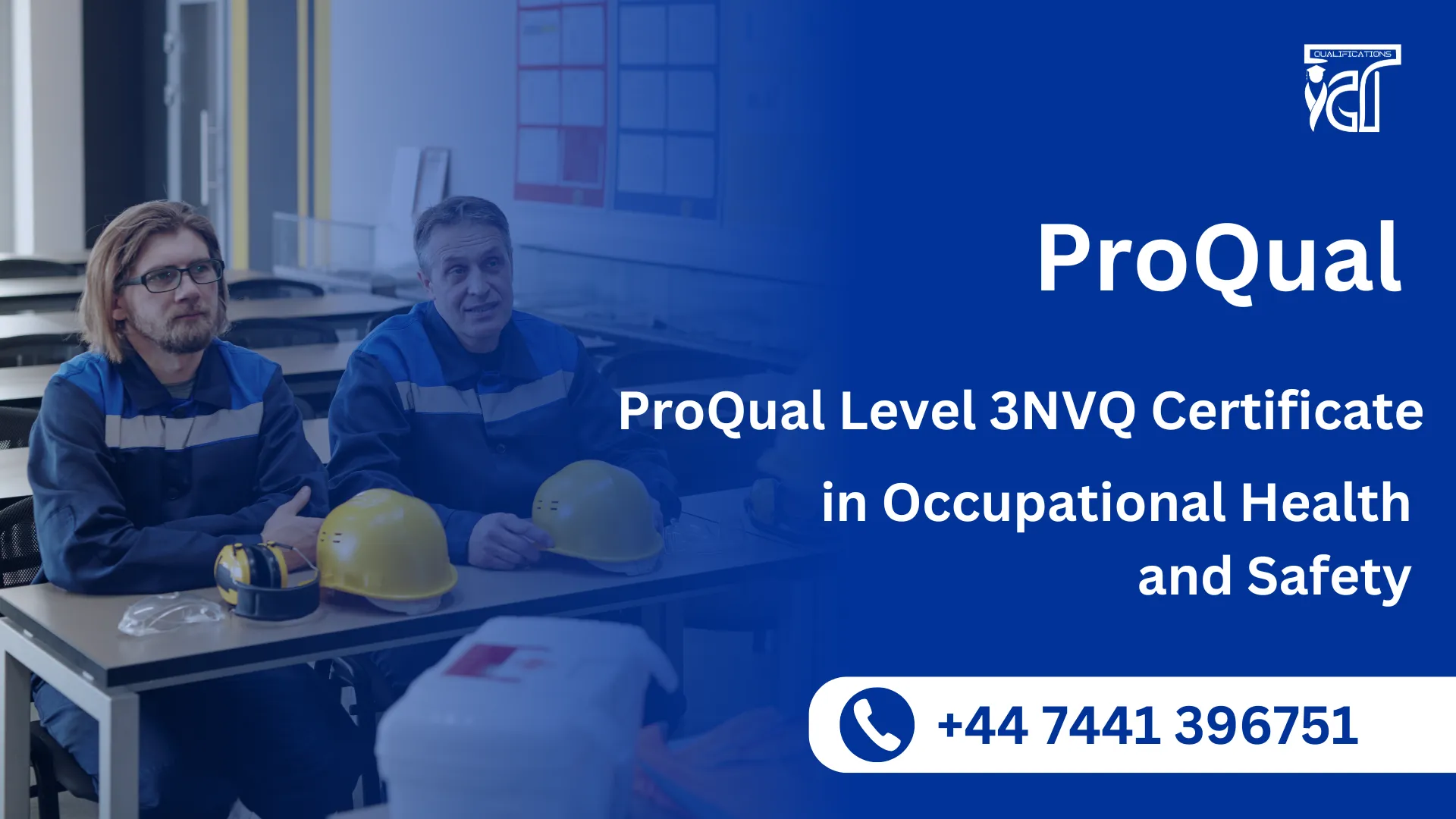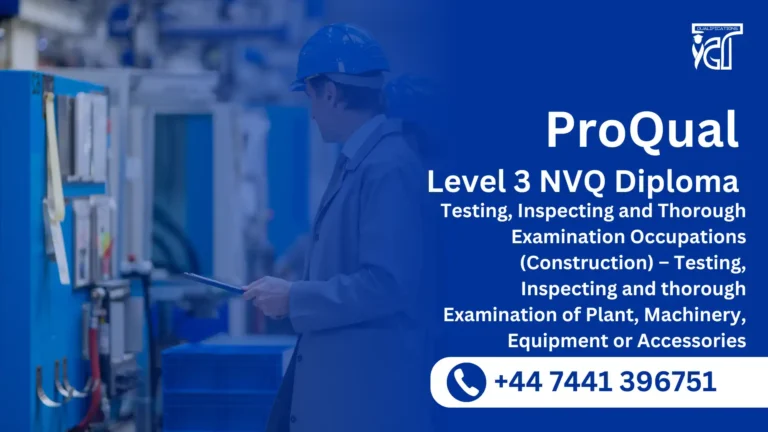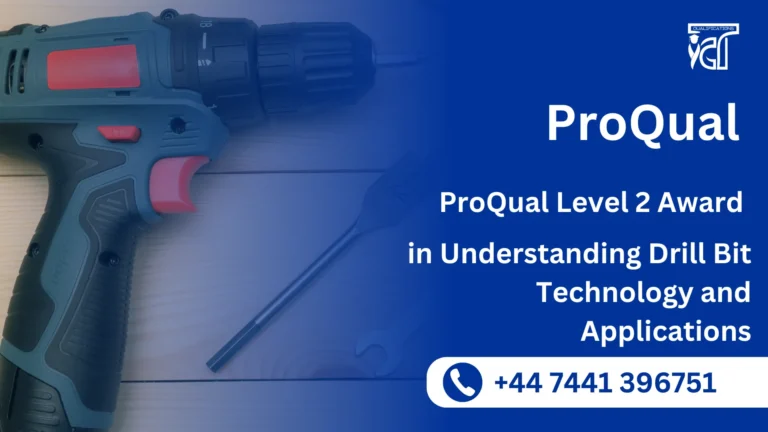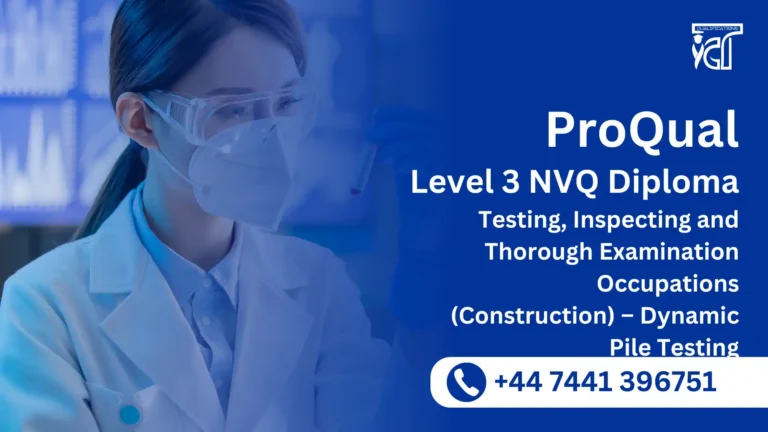The Level 3 NVQ Certificate in Occupational Health and Safety is a valuable qualification designed for individuals who want to build a solid foundation in health and safety management. This Ofqual-regulated qualification is entirely assignment-based, making it a flexible and practical choice for those already working in a health and safety role.
The Level 3 NVQ Certificate in Occupational Health and Safety is a competency-based qualification that demonstrates an individual’s ability to apply health and safety knowledge in a real workplace setting. It is ideal for professionals seeking to improve workplace safety, reduce risks, and ensure compliance with health and safety regulations.This qualification provides a strong foundation for further study, including the NVQ Level 6 Diploma in Occupational Health and Safety, which is required for Chartered Membership of IOSH (CMIOSH).
The Level 3 NVQ Certificate in Occupational Health and Safety is the perfect qualification for those looking to start or advance their careers in workplace safety. With its assignment-based structure, flexible learning format, and industry recognition, this course provides a strong foundation for further professional development.If you are committed to ensuring workplace safety and compliance, this qualification is an essential step toward achieving your career goals.
ProQual Level 3 NVQ Certificate in Occupational Health and Safety
The Level 3 NVQ Certificate in Occupational Health and Safety consists of 5 mandatory units and 4 Optional Units. Candidates must complete all of the following Mandatory units and any Two Optional units.
Mandatory Units of Level 3 NVQ Certificate in Occupational Health and Safety
| Sr# | Unit Title | Level |
|---|---|---|
| 1 | Ensure responsibility for actions to reduce risks to health and safety | 3 |
| 2 | Develop procedures to safely control work operations | 3 |
| 3 | Monitor procedures to safely control work operations | 3 |
| 4 | Promote a culture of health and safety in the workplace | 3 |
| 5 | Conduct a health and safety risk assessment of the workplace | 3 |
Optional Units of Level 3 NVQ Certificate in Occupational Health and Safety
Optional Units
| Sr# | Unit Title | Credit Value |
|---|---|---|
| 1 | Investigate and evaluate health and safety incidents and complaints in the workplace | 3 |
| 2 | Make sure actions in the workplace aim to protect the environment | 3 |
| 3 | Review health and safety procedures in the workplace | 3 |
| 4 | Supervise the health, safety and welfare of a learner in the workplace | 3 |
GLH (Guided Learning Hours) and TQT (Total Qualification Time) are terms commonly used in vocational qualifications to help define the amount of time a learner is expected to spend on their studies.
1. GLH (Guided Learning Hours)
GLH refers to the number of hours a learner spends being directly taught, supervised, or supported during their course. This includes the time spent in activities such as:
- Classroom instruction
- Practical workshops
- One-on-one tutoring or mentoring sessions
- Online learning sessions with tutor support
In other words, GLH represents the time that learners are actively engaged with their instructors or learning activities.
2. TQT (Total Qualification Time)
TQT represents the total amount of time a learner is expected to invest in completing a qualification, including:
- GLH (Guided Learning Hours): Time spent on direct learning, as explained above.
- Self-Directed Learning: This includes time spent on independent study, research, assignment completion, preparation for exams, and any other work the learner does outside of direct teaching hours.
TQT is a broader measure that includes all the time required to achieve the qualification. It helps learners and employers understand the overall commitment required for the qualification.
Key Differences Between GLH and TQT:
- GLH focuses on direct learning with guidance or supervision.
- TQT includes GLH as well as independent study time and other learning-related activities.
Example:
If a qualification has a TQT of 600 hours and a GLH of 250 hours, it means the learner should spend 250 hours in direct learning (classroom, online, or tutor-led sessions) and 350 hours on independent study or research.
Learning Outcomes for Level 3 NVQ Certificate in Occupational Health and Safety
Core Units
1. Ensure Responsibility for Actions to Reduce Risks to Health and Safety
- Understand individual and organizational responsibilities for health and safety.
- Identify hazards and assess associated risks in the workplace.
- Implement control measures to minimize risks and prevent accidents.
- Promote safe working practices among employees.
- Monitor and review safety measures to ensure compliance with regulations.
2. Develop Procedures to Safely Control Work Operations
- Identify workplace risks and develop appropriate health and safety procedures.
- Create clear, practical guidelines for safe work operations.
- Ensure procedures align with legal requirements and industry best practices.
- Communicate safety procedures effectively to all employees.
- Monitor compliance and update procedures as necessary.
3. Monitor Procedures to Safely Control Work Operations
- Oversee the implementation of workplace safety procedures.
- Identify and address non-compliance issues.
- Conduct regular audits and inspections to ensure effectiveness.
- Gather feedback from employees on safety procedures and make improvements.
- Keep records of monitoring activities and safety performance.
4. Promote a Culture of Health and Safety in the Workplace
- Encourage employee engagement in health and safety practices.
- Foster a proactive approach to risk management.
- Develop and implement training programs to raise safety awareness.
- Recognize and reward positive health and safety behaviors.
- Work collaboratively with management and staff to create a safety-conscious environment.
5. Conduct a Health and Safety Risk Assessment of the Workplace
- Identify potential workplace hazards and assess associated risks.
- Use risk assessment methodologies to evaluate hazards.
- Implement control measures to mitigate risks effectively.
- Document and review risk assessments regularly.
- Ensure compliance with legal and regulatory requirements.
Optional Units
1. Investigate and Evaluate Health and Safety Incidents and Complaints in the Workplace
- Understand the process of reporting and investigating workplace incidents.
- Identify root causes of health and safety incidents.
- Evaluate complaints related to workplace safety concerns.
- Implement corrective and preventive actions to avoid recurrence.
- Maintain records of investigations and outcomes.
2. Make Sure Actions in the Workplace Aim to Protect the Environment
- Identify environmental risks and assess their impact.
- Implement workplace policies to reduce environmental harm.
- Promote sustainable practices and responsible resource usage.
- Ensure compliance with environmental regulations.
- Monitor and review workplace environmental performance.
3. Review Health and Safety Procedures in the Workplace
- Assess the effectiveness of existing health and safety procedures.
- Identify areas for improvement and implement necessary updates.
- Ensure procedures align with changing legal requirements.
- Involve employees in the review process to gather insights.
- Maintain records of procedure reviews and updates.
4. Supervise the Health, Safety, and Welfare of a Learner in the Workplace
- Provide guidance and support to learners regarding workplace safety.
- Ensure learners understand and follow safety procedures.
- Identify and mitigate potential risks to learner safety.
- Promote a positive and safe learning environment.
- Monitor and assess the learner’s progress in health and safety complianc
Benefits of the ProQual Level 3 NVQ Certificate in Occupational Health and Safety
The ProQual Level 3 NVQ Certificate in Occupational Health and Safety is a valuable qualification for professionals seeking to enhance their expertise.
1. Widely Recognized and Ofqual-Regulated Qualification
This nationally accredited qualification is regulated by Ofqual, ensuring it meets rigorous standards. It’s trusted by employers across industries, making it a valuable credential for those pursuing a career in occupational health and safety.
2. No Exams – Evidence-Based Assessment
There are no stressful written exams. Instead, you’ll be assessed through practical assignments and evidence collected from your current workplace. If something doesn’t meet criteria, you’ll receive feedback and can resubmit—ensuring you achieve success without pressure.
3. Learn Through Real-World Experience
The course is based entirely on the tasks and responsibilities you already carry out at work. This ensures your learning is directly applicable and enhances your daily performance in real health and safety environments.
4. Flexible Study Options That Fit Your Schedule
With self-paced learning and remote portfolio submission, you can complete the qualification around your existing job and personal life. It’s designed for working professionals who need flexibility without compromising quality.
5. Stronger Career Opportunities in Safety Roles
Completing this NVQ can help you step into roles like Health and Safety Officer, Safety Coordinator, Risk Assessor, or Site Compliance Supervisor. It’s a great first step for anyone looking to build a long-term career in health and safety management.
6. Core Skills in Risk Management and Compliance
You’ll develop a strong command of key safety practices such as risk assessments, incident investigations, legal compliance, and safe working systems—skills highly valued across all sectors.
7. Cost-Effective Professional Development
Because the NVQ is work-based, you won’t need to take time off or attend costly in-person sessions. You’re learning as you work, making it a budget-friendly option for both individuals and employers.
8. Clear Progression Path to Higher Qualifications
This qualification forms a strong foundation for advanced certifications like the Level 4 or Level 6 NVQ Diplomas in Occupational Health and Safety. It also supports applications for professional memberships such as TechIOSH.
9. Enhanced Credibility in the Workplace
Employers value professionals who hold recognized, regulated qualifications. This certificate shows your dedication to safety and compliance and positions you as a trusted health and safety representative or leader.
10. Globally Applicable Skills and Recognition
Although it’s based on UK standards, the ProQual Level 3 NVQ is respected internationally. It’s ideal for those working in global companies or safety-focused industries looking for standardized, high-quality training.
Best Fit for the ProQual Level 3 NVQ Certificate in Occupational Health and Safety
ProQual Level 3 NVQ Certificate in Occupational Health and Safety is ideal for individuals who are currently working in a role that involves health and safety responsibilities and want to enhance their knowledge and career prospects. The best fit for this course includes:
- Health and Safety Assistants or Officers who want to advance into more senior roles
- Site Supervisors, Team Leaders, and Line Managers responsible for safety on-site or across teams
- Employees with health and safety responsibilities looking to improve compliance and workplace safety
- Those working in high-risk sectors such as construction, manufacturing, logistics, engineering, and healthcare
- Individuals new to the field who have access to a relevant job role where they can demonstrate required competencies
- Contractors or self-employed professionals who need a recognized qualification to meet client or legal requirements
- Employees aiming for TechIOSH status and a stepping stone to higher-level qualifications like the Level 6 NVQ Diploma in Occupational Health and Safety
Whether you’re enhancing your current position or building a safety-focused career path, this course empowers you to lead safe practices, manage risk effectively, and contribute to a culture of compliance and prevention.
Completing the ProQual Level 3 NVQ Certificate in Occupational Health and Safety is more than just gaining a respected qualification it’s a strategic step forward in your professional development. This certification lays the groundwork for higher-level roles, advanced training, and industry recognition.
1. Advance to a Level 6 NVQ Diploma in Occupational Health and Safety Practice
This is the natural next step and is ideal for professionals aiming for senior roles such as Health and Safety Manager, Compliance Lead, or Safety Consultant. The Level 6 NVQ is also a pathway to Graduate IOSH (GradIOSH) and eventually Chartered Membership (CMIOSH).
2. Apply for TechIOSH Membership
With a Level 3 NVQ, you may be eligible for Technical Membership with the Institution of Occupational Safety and Health (TechIOSH). This membership enhances your professional credibility and opens doors to networking, resources, and international recognition.
3. Explore Specialized Safety Certifications
Depending on your career goals or industry, you could expand into areas such as:
- Fire Safety and Risk Management
- Construction Safety
- Environmental Management Systems
- Accident Investigation or Auditing
These focused qualifications can help you become a subject matter expert in your field.
4. Progress into Leadership Roles
Armed with practical experience and a recognized qualification, you’ll be ready to take on positions like:
- Health and Safety Supervisor
- Risk Assessor
- Compliance Coordinator
- Safety Trainer or Advisor
Your ability to manage safety systems and promote compliance will set you apart in any organization.
5. Work Internationally
The NVQ structure and Ofqual regulation ensure your skills are transferable across borders, making this qualification valuable for those looking to work with international organizations or in countries that recognize UK health and safety standards.
6. Start a Career in Health and Safety Consultancy
With real-world experience and a Level 3 NVQ under your belt, you may choose to offer your services as an independent safety consultant supporting small businesses, construction sites, or industrial operations with compliance and training needs.
7. Lay the Foundation for a Long-Term Safety Career
Whether you aim to reach CMIOSH status or become a leading expert in workplace safety, this Level 3 certificate provides the core skills, compliance understanding, and credibility you need to build a successful long-term career.
Entry Requirements
Register Now
Qualification Process
Qualification Process for the ProQual Level 3 NVQ Certificate in Occupational Health and Safety
- Self-Assessment:
Begin by evaluating your eligibility to ensure you meet the qualification requirements, including work experience, knowledge, and language proficiency. - Registration:
Complete your registration by submitting the required documents, including a scanned copy of a valid ID, and paying the registration fee. - Induction:
An assessor will conduct an induction to confirm your eligibility for the course and explain the evidence requirements. If you do not meet the criteria, your registration will be canceled, and the fee will be refunded. - Assignmnets & Evidence Submission:
Provide all assignmnets and the necessary evidence based on the assessment criteria outlined in the course. If you are unsure of the required evidence, consult with the assessor for guidance on the type and nature of evidence needed. - Feedback and Revision:
The assessor will review your submitted evidence and provide feedback. Evidence that meets the criteria will be marked as “Criteria Met,” while any gaps will be identified. You will be asked to revise and resubmit if needed. - Competence Evidence:
Submit final evidence demonstrating that all learning outcomes have been met. This evidence will be marked as “Criteria Met” by the assessor once it is satisfactory. - Internal Quality Assurance (IQA):
The Internal Quality Assurance Verifier (IQA) will review your evidence to ensure consistency, quality, and compliance with standards. - External Verification:
The IQA will submit your portfolio to ProQual’s External Quality Assurance Verifiers (EQA) for final confirmation. The EQA may contact you directly to verify the authenticity of your evidence. - Certification:
Upon successful completion of all checks, ProQual will issue your official certificate, confirming that you have attained the ProQual Level 3 NVQ Certificate in Occupational Health and Safety .
FAQs for ProQual Level 3 NVQ Certificate in Occupational Health and Safety







